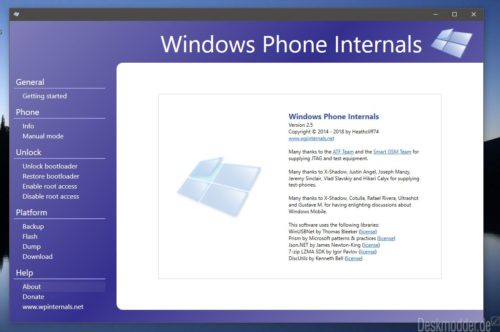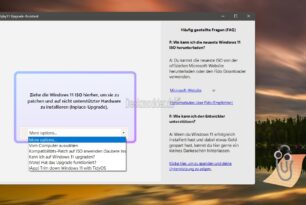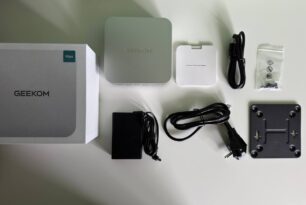Wer mit Windows Phone oder Windows 10 Mobile unterwegs ist kennt vielleicht auch die Windows Phone Internals (WPinternals). Im Februar kam das letzte Update, was persönliche Gründe hatte. Nun wurden die WPinternals auf die Version 2.5 aktualisiert. Diese Version enthält sehr viele Korrekturen und auch neue Funktionen. Wie Rene schreibt, werden nun auch die neuesten Windows 10 Mobile Versionen unterstützt.
„Unterstützung für Windows Mobile 10.0.15254.490 und 10.0.15254.527, sowohl für SecureBoot entsperren als auch für Root Access.“ Interessant für die Bastler: Diese Version ermöglicht es auch, benutzerdefinierte ROMs mit hochgradig anpassbaren Partitionslayouts zu erstellen. Erklärung dazu in der Changelog.
Neue Funktionen in den Windows Phone Internals 2.5
- The archive of a Custom ROM can contain a file named „Partitions.xml“. When this file is present, it is parsed and merged with the existing partition-table on the phone. You can get an example of such XML-file by using the commandline to create a backup of the partition-table of the phone. The Partitions.xml file inside the archive does not need to be complete.
Only new partitions and modified partitions need to be present inside the XML-file. For modified partitions, you only need the name and the modified properties. Other elements can be omitted. The information in the XML-file will be merged into the existing partition-table. This behavior can be tested using the commandline-function MergeGPT.
- Support for Windows Mobile 10.0.15254.490 and 10.0.15254.527, for both SecureBoot unlock and Root Access.
- You can add an existing FFU-file to the repository on the download-page of Windows Phone Internals.
Fehlerbehebungen in den Windows Phone Internals 2.5
- On a small number of Lumia phones Windows Phone Internals was not able to find a Flashing Profile. The parameters which
were checked have been extended in this version. This problem should be fixed now for most phones. - Windows Phone Internals 2.4 could crash when launched on Windows 7. This is fixed. In Windows Phone Internals 2.4 there was a fix for detecting misbehaving Mass Storage drivers. This detection doesn’t work properly on Windows 7. When Windows Phone Internals is
launched on Windows 7 the detection for misbehaving Mass Storage drivers is disabled.So Windows Phone Internals doesn’t crash anymore on Windows 7, but for most stable unlocking behavior you should launch Windows Phone
Internals on Windows 8.1 or on Windows 10. - When a corrupt FFU-file was used for unlocking, Windows Phone Internals could crash. FFU-files can get corrupted when the
download is aborted. Windows Phone Internals will now verify the headers and the length of the FFU-file before the
unlock-process starts. - Under some circumstances a phone could get stuck in Flash-mode after a stock FFU was flashed. This behavior is detected
and in this case the phone is first relocked before the stock FFU is flashed to fix this problem. - Relocking a phone that was not unlocked, could leave the phone in flash-mode.
- When a phone in Mass Storage mode has had a drive-letter assigned to partitions other than MainOS, the next time these drive-letters are also assigned. When a phone is unlocked, the extra drive-letters could confuse the unlock-process. Unlocking now checks the partition-names for correct behavior.
- When unlocking a phone with Bootloader Spec A, which was already updated with new firmware, Windows Phone Internals could crash due to unexpected changes in the partition-layout. This is now detected and handled properly.
- Some driver versions for Qualcomm Emergency Download mode failed to report a correct Bus Name. Because of this Windows Phone Internals was not able to detect the phone properly when it was switching to Emergency Download Mode. This could make Windows Phone Internals hang while trying to switch to Emergency Download mode when the phone was being unlocked. When the Bus Name in the driver is missing, Windows Phone Internals will make some assumptions to unlock the phone successfully.
- On some engineering Lumia’s the function to switch to Mass Storage Mode did not work properly.
- When there is no Profile FFU available, the button to restore the bootloader was disabled without a warning. Under these circumstances this new version will display a proper warning.
Einschränkungen
- After unlocking the bootloader, the iris scanner does not work anymore on Lumia 950 and Lumia 950 XL. This is a limitation of SecureBoot Unlock v2. I already spent a fair amount of time to find a solution and I made some progress, but so far I haven’t found the root cause yet. To fix the problem you can restore the bootloader. Some people have reported that the Iris-scanner works after the phone is unlocked for the second time.
- Due to the complexity of SecureBoot Hack v2, unlocking mounted ROM images is only possible for Lumia’s with Bootloader Spec A. For Lumia’s with bootloader Spec B you can create Custom ROM’s with Root Access using the „Build and capture“ technique, as described on the Getting started page.
- Occasionally the Mass Storage drivers on the PC can misbehave. In this case, the phone will be in mass storage mode, but the PC does not recognize it. This could affect the unlock process. Windows Phone Internals now has a detection-method for this behavior, but that only works on Windows 8.1 and Windows 10. So for the most stable unlock-experience, you should avoid Windows 7 or older.
- Lumia’s with Bootloader Spec B can only flash partitions on a 0x100 sector-boundary (or 0x20000 bytes-boundary). Your partition-layout should comply to this rule. When Windows Phone Internals calculates a new partition layout for a Custom ROM, the layout will automatically comply to this rule.
- The phone may boot to a Blue Screen after unlocking the bootloader. This is a limitation of SecureBoot Unlock v2. Some Windows 10 based phones need additional modifications to be able to boot properly after the bootloader is unlocked. The patches will be applied automatically if the OS on the phone is on a supported version. In case the phone doesn’t boot properly, you can still enter Mass Storage Mode if you want. To boot properly again, restore the bootloader. You can update to a supported OS version and try again after that.
- Some Silverlight apps may not work. This is a limitation of SecureBoot Unlock v2. The cause of this problem is known. For now this problem can be fixed by enabling Root Access on the phone.
- Some phones, namely the Lumia 535 models, may experience problems during the unlock process. The first part of the unlock succeeds, but when the phone is being switched to Mass Storage Mode, it is not able to find a working Flashing Profile anymore. This issue is under investigation.
- When you try to unlock or relock a phone with a non-supported OS version, then you will need to provide a donor-FFU with a supported OS-version. When unlocking or relocking the phone, modifications will be made to the phone, which may also cause the existing flashing-profile to become invalid. In this case Windown Phone Internals may need to search for a new flashing profile during any unlock- or relock-attempt.
- Windows Phone Internals supports only one single connected phone at a time. When multiple phones are connected, Windows Phone Internals can start showing unexpected and unstable behaviour.









Hallo zusammen,
gibt es auch irgendwo eine deutsche Beschreibung oder ein deutsches Tutorial? Danke
„Wer mit Windows Phone oder Windows 10 Mobile unterwegs …“
Ja hier, ich bin einer von den fünf (weltweit), der noch ein Windows Mobile 10 betreibt, Und finde es sehr, sehr nett, daß der Entwickler für uns 5 Männeken überhaupt noch was tut.
Mein L950XL dankt auf jeden Fall herzlich.
Im Übrigen, sagte ich schon, daß ich durchhalte? Auch über 2019 hinaus? Und wenn ich der allerletzte mit einem Windows Mobile bin. Und auch, wenn es außer den mitgelieferten überhaupt keine anderen Apps mehr gibt. Werden sowieso überbewertet. Für jeden Lötzinn ’ne App. Wie haben wir eigentlich überlebt, als es diesen Quatsch noch nicht gab?
Viele Grüße
Dann sind wir schon zwei die durchhalten
Ich würdt sagen 3 ,hier ein 950 im Einsatz.
gepostet mit der Deskmodder.de-App
4 Gruß von meinem Alcatel Idol 4 Pro
gepostet mit der Deskmodder.de-App
Hurrrra.
Bin nicht allein.
Nr. 5 lebt??
gepostet mit der Deskmodder.de-App
Nr. 6 lebt auch noch mit einem Lumia 650. Brauchen wir noch einen und die 7 Zwerge sind komplett.
gepostet mit der Deskmodder.de-App
Die 7 Zwerge sind komplett…
Lumia 950.
Jetzt sind es „The Hateful 8“ mit einem Lumia 950 XL.Sorry was anderes viel mir bei 8 nicht ein ?
gepostet mit der Deskmodder.de-App
Nummer 9 hat letzte Woche aufgegeben. Das Lumia 930 wird nur noch zum fotografieren und surfen genutzt.
Na gut, dann mache ich mal die 10 voll. ( L950XL)
Schade, dass die Beschreibung komplett in englisch ist. Muss ich wieder den Translater anschmeißen.
Dann reihe ich mich mal als Nr. 11 ein… Lumia 540 XL
gepostet mit der Deskmodder.de-App
sorry… 640 XL
gepostet mit der Deskmodder.de-App
braucht man nicht, lieber die App Qualität insgesamt verbessern, damit man eine Alternative zu Android haben kann
gepostet mit der Deskmodder.de-App
Im muß im Geschäft mit diesem Schrott auf einem Lumia leben. Ich warte nun auf den Tag im Oktober wo wir endlich auf Android umsteigen. Die Software hat nach Jahren die selben Bugs, Bedienung ist nicht intuitiv etc. Das einzig gute ist die Qualität von Nokia, denn so oft wie das Teil durch den Raum geflogen ist und trotzdem fast unversehrt geblieben ist.
Also bei uns sind 3 Lumias im Einsatz 950 XL, 640 XL und das 925. Wir sind immer noch sehr zufrieden und ich werde den Teufel tun mir diesen Android Quatsch ins Haus zu holen. Wir werden die Geräte so lange nutzen wie sie halt funktionieren.
gepostet mit der Deskmodder.de-App
Auch ich bin noch mit dem Lumia 950 unterwegs. Werde es auch behalten, solang es geht.
gepostet mit der Deskmodder.de-App
version 2.6 ist da